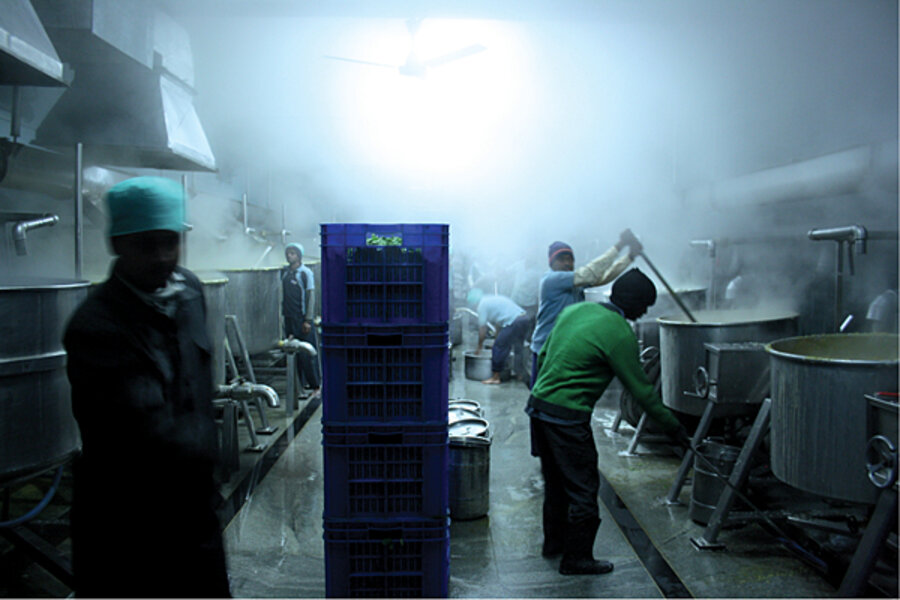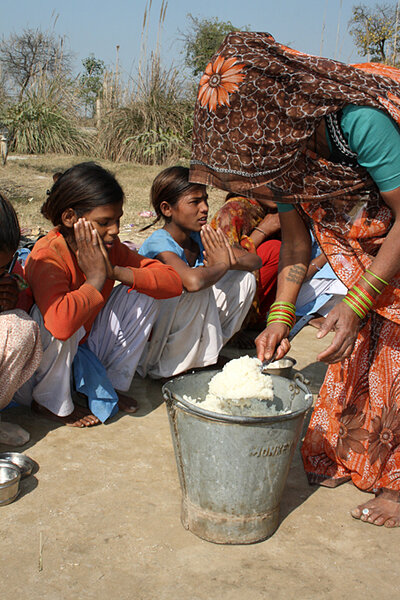How India feeds 120 million kids a day
Loading...
| Beri, India
Shamvir Singh says he downs a glass of milk before walking to school, but when asked what else he eats at home, the 12-year-old droops his head in silence.
He is embarrassed, but none of the other students who are crowded around him in the dusty junior high school courtyard tease him. Half of them, estimates the principal, only get one meal a day: the free hot lunch offered at schools around India.
"Children from very poor farming families now come regularly; they look forward to the meal," says Shiv Singh, the headmaster of the Shri Krishak school in Beri, a village three hours south of New Delhi. "They used to go off to help their parents farm."
Shamvir and his classmates squat in the dirt, watching as the sari-draped lunch ladies go down lines filling the metal bowls in front of them.
The Indian government provides free hot lunches to 120 million students a day, the largest school lunch program in the world. For comparison, the United States provided low-cost or free lunches to some 31 million children a school day in 2009.
The massive undertaking started as a flawed welfare program that has been improved with the help of a Hindu religious group teaming up with some of India's top engineers.
The reforms by the group, the Akshaya Patra Foundation, are expanding school attendance, cutting down on hunger, and, anecdotally, lifting caste divisions. Some of their innovations in food processing also hint at the potential for adding value to India's bountiful crops in ways that serve the poor who grow them.
Initially, under the national mid-day meal program, free grain was distributed to parents and school kids were sent home for lunch break. The problem: Many families sold the grain and the kids went hungry.
That was the case in Berii. Headmaster Mr. Singh points to one of the eldest girls. "She returned late to school every day and when asked why, she said, 'There was no food.' "
The scale of India's hunger issue becomes clear
In 2000, a group of Hare Krishnas in Bangalore noticed the problem. They began to take the rations and deliver a daily cooked meal to a few local schools, building on a Hindu tradition of serving meals for the poor.
Soon the group received letters from other schools wanting to be included. Within months the requests totaled 100,000.
"We were shocked," says Suvyakta Das, a president of Akshaya Patra, the secular foundation formed by the Hare Krishnas to do this charity work. "We didn't realize the scale of this issue in Bangalore."
They would soon learn the scale of the issue nationwide, but for the moment the question was how to cook 100,000 lunches a day?
"Everybody said, 'This scale? Sorry,' " says Mr. Das. However Das – who graduated from a top engineering university in India – along with other engineer devotees in the group designed "centralized kitchens" capable of churning out more than 100,000 lunches every morning.
The kitchen managed by Das in Vrindivan, a town near Beri, opens at 2 a.m., and by 9 a.m. the food is on trucks headed to 1,500 nearby schools. Mostly this is done by machine, requiring just 65 workers.
One machine can churn out 40,000 rotis – a circular flat bread – an hour. Workers pack the hot rotis in insulated canisters until a specific weight is reached for each school.
With the help of the kitchens, Akshaya Patra now feeds 1.2 million children a day. An impact assessment by ACNielsen found the program has succeeded in raising school enrollments in various regions, some by as much as 15.3 percent. Attendance also jumped in some places by more than 10 percent.
In 2001, noting Akshaya Patra's success, India's Supreme Court ordered the government to provide hot lunches nationwide – a mandate only widely implemented in recent years.
Still, the needs are vast, and India remains home to about a quarter of the world's hungry poor, according to the UN's World Food Program. The ACNielsen assessment found only marginal improvements in nutrition and scholastic performance.
But is the program making a difference?
Detractors of the midday meal program point out that it focuses government funding on school-age children when the most critical time for malnutrition is age 2 and under. Almost half of all Indian children under 5 years old are stunted due to chronic undernutrition.
Das says that earlier interventions to improve nutrition would make it easier to tackle the problems of hunger. So Akshaya Patra is expanding on the government program to offer meals in nurseries accessible to pregnant mothers.
Many schools not covered by Akshaya Patra hire villagers to cook government rations and have to contend with poor hygiene and rodents. But the centralized kitchen model continues to spread.
"We have full control over the ingredients that go into it, the taste, the safety," says Das, who notes the kitchens meet international food safety standards. And buying in bulk makes it cheap to supplement the government rations with more vegetables and healthier ingredients.
While Akshaya Patra is a secular foundation that serves children of all religions, the group uses its religious ties. The centralized kitchens hire workers from any caste, even those historically considered unclean by upper-caste Hindus.
"This is where our religious background also helps," says Das, himself a Hindu monk. The food is made on religious sites, he says, so parents "stay quiet" about traditional taboos.
Das adds that the standardization of the meals helps instill a greater sense of equality.






